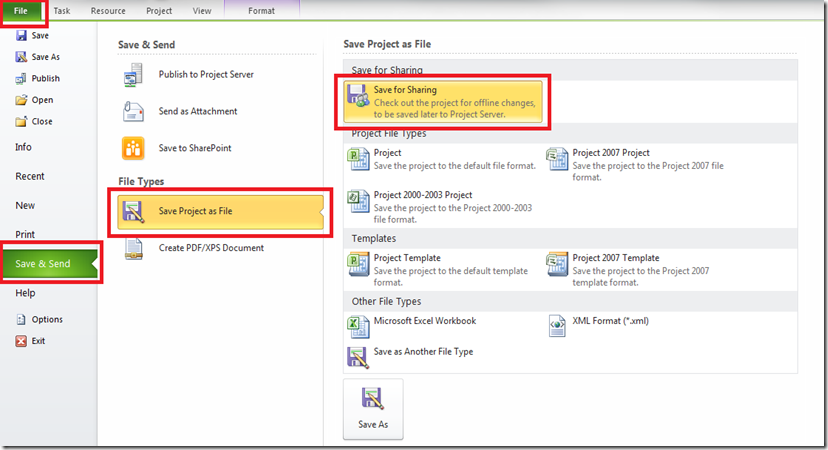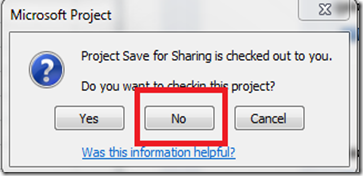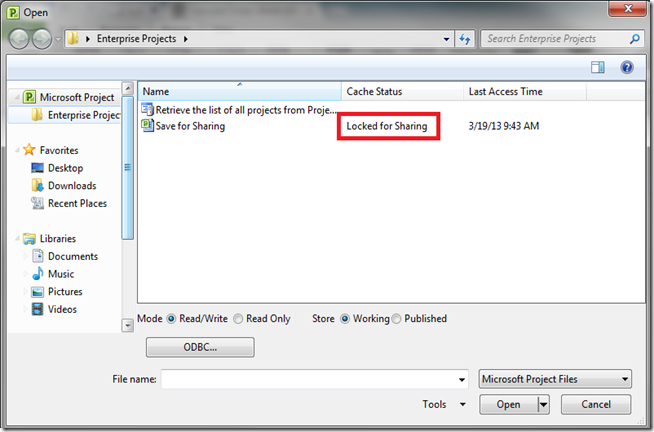While most companies are open to hiring contractors for their projects, they are still skeptical on giving them access to their network. We have many clients that, while want contractors to work on their project and provide input to the project schedule, do not like the idea of granting them access to their Project Server. Fortunately, Microsoft recognized this and included a feature called ‘Save for Sharing’. Probably the first question in your mind right now is – When would I want to use this feature? Let’s say you have a Project schedule created and published to your Project server. You and your team have been working on this project for a couple of month, but you come across a part of the project that requires additional skills that you did not account for during the planning stage. Because you and your team are in a time crunch, you decide to hire contractors that will help you on this specific part of the project. But you want to record and track the task that will be performed by this contractor. You would like to have the contractor add his task to the Project schedule. There are 3 ways in which you can achieve this –
1. Create an account for the contractor and grant him/her access to Project Server – While the easiest option will be to create an account and grant that account permission to update the Project, many companies look at this as a security risk and would rather not grant them access to their system.
2. Download a local copy of the Microsoft Project schedule and then Email – For this method, do the following a. Project Manager opens Microsoft Project Professional and connects to the server. b. Clicks on File -> Open c. Select the project that needs to be shared. d. Click on File -> Save As e. Click on ‘Save as File’
f. Provide a location where you would like to save this file (for ex: Desktop) g. Once Saved, Close and Check in the Project. h. Send the downloaded copy of the project to the contractor for updates. i. When you receive the updated file, open Microsoft Project professional and connect to the server. j. Click File -> Open and browse to the location where you downloaded the updated file. k. Click on File -> Save As l. Enter the same name in the Name box of the ‘Save to Project Server’ dialog box (Very important that you use the same name).
m. Click ‘Save’. n. You will get a dialog box, informing you that a project with the same name already exists. Click OK to replace the project.
The problem with this method is, while you are waiting on the contractor to send you the updated file, users that have permissions to update the project can still make changes to it. Now, when you overwrite the project with the one you receive from the contractor, these changes will be lost. Some might argue that you could keep the project Checked out to you so no one can make changes to the project while we are waiting. Let’s see what happens when you have the project checked out to you. Instead of Check in the project as listed in Step ‘g’ in the instruction above, click on File -> Close. Click No when asked to Check in the Project.
Now when you get the updated copy of the project from the contractor and you try to save the file back to the server you will get the following message
3. Use the Save for Sharing feature. Follow these steps – a. Project Manager opens Microsoft Project Professional and connects to the server. b. Clicks on File -> Open c. Select the project that needs to be shared. d. Click on File -> Save & Send -> Save Project as file -> Save for Sharing 
e. Provide a location where you would like to save the file (example Desktop) f. Once Saved, Click on File -> Close g. Send this file to the contractor for updates. h. Once you receive the updated copy, Open Microsoft Project Professional and connect to the server. i. Click on File -> Open j. Browse to the location where you downloaded the file and then select the file and click Open k. Click File -> Save As l. Notice that the Name box in the ‘Save to Project Server’ dialog box is greyed out and has the original name of the project. m. Click Save. If, a user with proper permissions tries to open the Project while we are waiting on the contractor to send us the updated file, he/she will see the following –
This method ensures that there are no duplicate projects created since it locks the Project Name filed. It also ensures that other users are not able to modify the project while we are waiting to receive the updated file. Although this feature is intended as a way to share a project with others so that they can update it, the surprise benefit of Save for Sharing is that it also repairs a corrupted enterprise project. Please follow the steps outlined here by Dale Howard.
Thanks very much for reading, I hope this helps you. If you need any help feel free to send me an email or leave a comment below. LinkedIn – www.linkedin.com/in/parthivbhuta







